PEN152: Assignment 1 - Physics Problems, Solutions, and Analysis
VerifiedAdded on 2023/04/10
|12
|1752
|374
Homework Assignment
AI Summary
This document presents solutions to a series of physics problems from PEN152 Assignment 1. The assignment covers a range of topics including calculations of atomic spacing in crystalline structures, analysis of the classic dollar bill catch experiment using kinematics, projectile motion calculations to determine firing angles, and projectile range calculations considering mountain obstacles. Additional problems include calculations involving spacecraft weight and orbital mechanics, ranking fuels by energy density, and analyzing energy expenditure for weight loss through stair climbing. The solutions are detailed, providing step-by-step calculations, explanations, and relevant equations. The document also includes a reference list for further study.
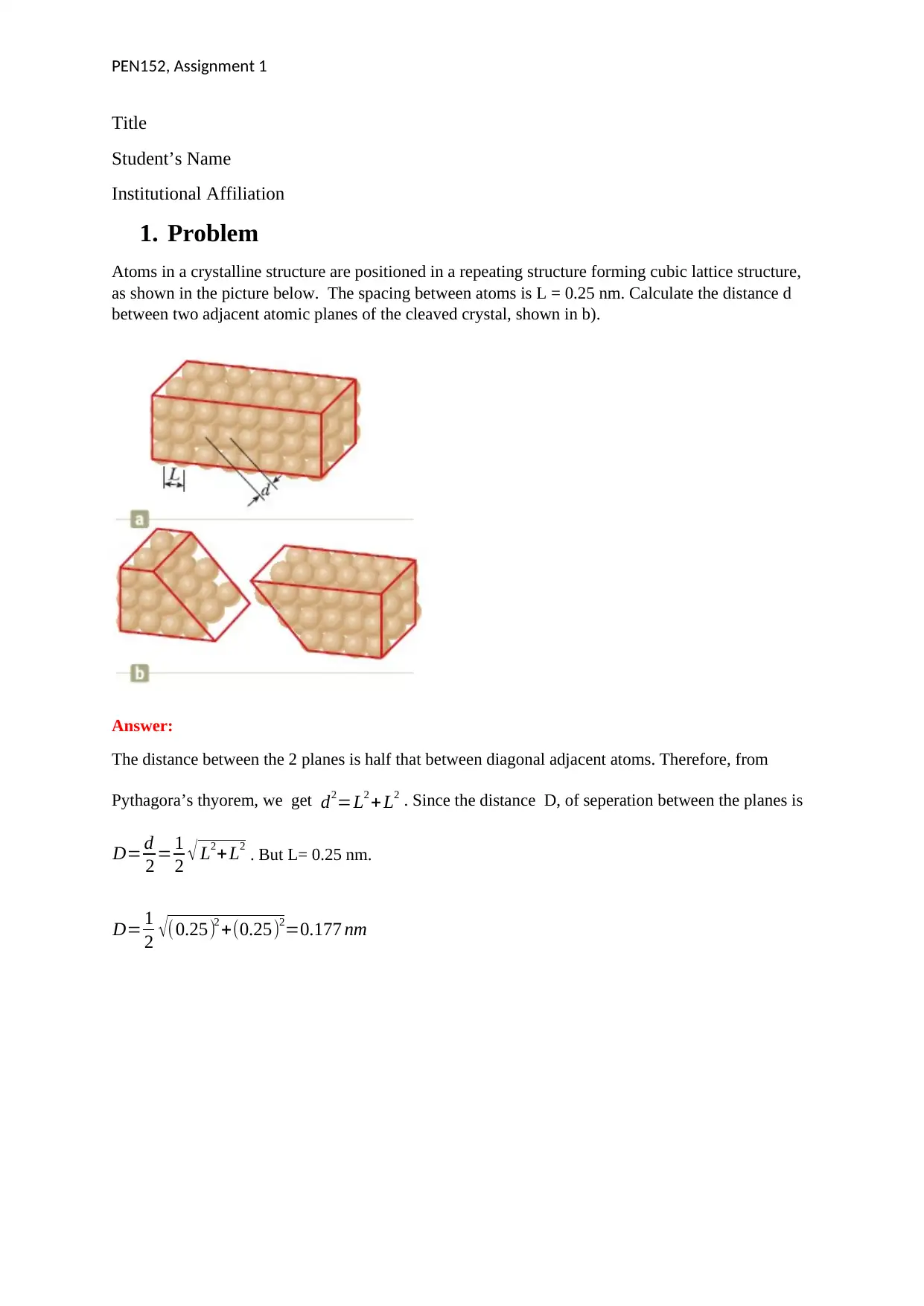
PEN152, Assignment 1
Title
Student’s Name
Institutional Affiliation
1. Problem
Atoms in a crystalline structure are positioned in a repeating structure forming cubic lattice structure,
as shown in the picture below. The spacing between atoms is L = 0.25 nm. Calculate the distance d
between two adjacent atomic planes of the cleaved crystal, shown in b).
Answer:
The distance between the 2 planes is half that between diagonal adjacent atoms. Therefore, from
Pythagora’s thyorem, we get d2=L2 + L2 . Since the distance D, of seperation between the planes is
D= d
2 = 1
2 √ L2+L2 . But L= 0.25 nm.
D= 1
2 √(0.25)2 +(0.25)2=0.177 nm
Title
Student’s Name
Institutional Affiliation
1. Problem
Atoms in a crystalline structure are positioned in a repeating structure forming cubic lattice structure,
as shown in the picture below. The spacing between atoms is L = 0.25 nm. Calculate the distance d
between two adjacent atomic planes of the cleaved crystal, shown in b).
Answer:
The distance between the 2 planes is half that between diagonal adjacent atoms. Therefore, from
Pythagora’s thyorem, we get d2=L2 + L2 . Since the distance D, of seperation between the planes is
D= d
2 = 1
2 √ L2+L2 . But L= 0.25 nm.
D= 1
2 √(0.25)2 +(0.25)2=0.177 nm
Paraphrase This Document
Need a fresh take? Get an instant paraphrase of this document with our AI Paraphraser
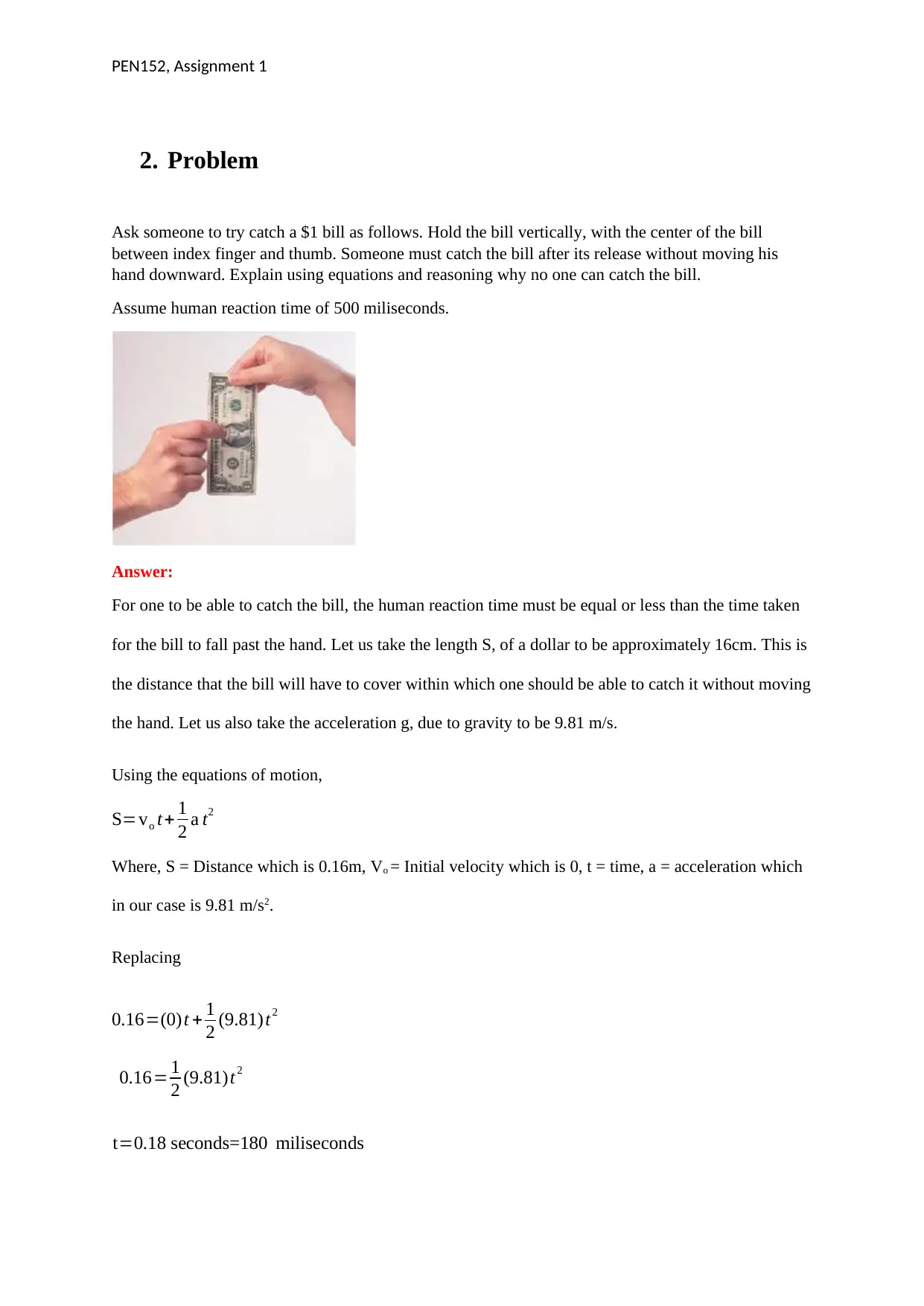
PEN152, Assignment 1
2. Problem
Ask someone to try catch a $1 bill as follows. Hold the bill vertically, with the center of the bill
between index finger and thumb. Someone must catch the bill after its release without moving his
hand downward. Explain using equations and reasoning why no one can catch the bill.
Assume human reaction time of 500 miliseconds.
Answer:
For one to be able to catch the bill, the human reaction time must be equal or less than the time taken
for the bill to fall past the hand. Let us take the length S, of a dollar to be approximately 16cm. This is
the distance that the bill will have to cover within which one should be able to catch it without moving
the hand. Let us also take the acceleration g, due to gravity to be 9.81 m/s.
Using the equations of motion,
S=vo t+ 1
2 a t2
Where, S = Distance which is 0.16m, Vo = Initial velocity which is 0, t = time, a = acceleration which
in our case is 9.81 m/s2.
Replacing
0.16=(0)t + 1
2 (9.81)t2
0.16= 1
2 (9.81)t2
t=0.18 seconds=180 miliseconds
2. Problem
Ask someone to try catch a $1 bill as follows. Hold the bill vertically, with the center of the bill
between index finger and thumb. Someone must catch the bill after its release without moving his
hand downward. Explain using equations and reasoning why no one can catch the bill.
Assume human reaction time of 500 miliseconds.
Answer:
For one to be able to catch the bill, the human reaction time must be equal or less than the time taken
for the bill to fall past the hand. Let us take the length S, of a dollar to be approximately 16cm. This is
the distance that the bill will have to cover within which one should be able to catch it without moving
the hand. Let us also take the acceleration g, due to gravity to be 9.81 m/s.
Using the equations of motion,
S=vo t+ 1
2 a t2
Where, S = Distance which is 0.16m, Vo = Initial velocity which is 0, t = time, a = acceleration which
in our case is 9.81 m/s2.
Replacing
0.16=(0)t + 1
2 (9.81)t2
0.16= 1
2 (9.81)t2
t=0.18 seconds=180 miliseconds
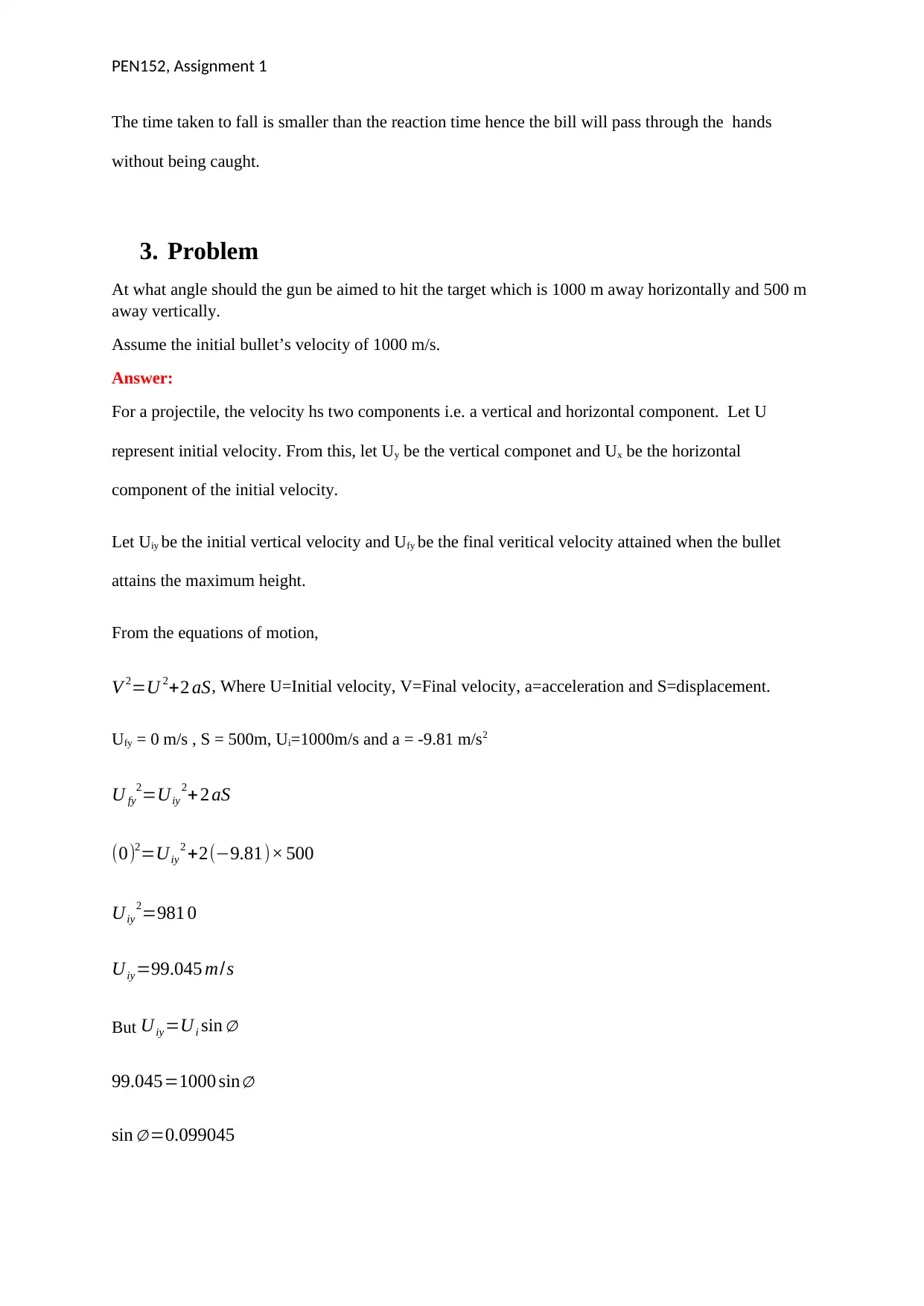
PEN152, Assignment 1
The time taken to fall is smaller than the reaction time hence the bill will pass through the hands
without being caught.
3. Problem
At what angle should the gun be aimed to hit the target which is 1000 m away horizontally and 500 m
away vertically.
Assume the initial bullet’s velocity of 1000 m/s.
Answer:
For a projectile, the velocity hs two components i.e. a vertical and horizontal component. Let U
represent initial velocity. From this, let Uy be the vertical componet and Ux be the horizontal
component of the initial velocity.
Let Uiy be the initial vertical velocity and Ufy be the final veritical velocity attained when the bullet
attains the maximum height.
From the equations of motion,
V 2=U 2+2 aS, Where U=Initial velocity, V=Final velocity, a=acceleration and S=displacement.
Ufy = 0 m/s , S = 500m, Ui=1000m/s and a = -9.81 m/s2
U fy
2=Uiy
2+2 aS
(0)2=Uiy
2 +2(−9.81)× 500
Uiy
2=981 0
Uiy =99.045 m/s
But Uiy =Ui sin ∅
99.045=1000 sin∅
sin ∅=0.099045
The time taken to fall is smaller than the reaction time hence the bill will pass through the hands
without being caught.
3. Problem
At what angle should the gun be aimed to hit the target which is 1000 m away horizontally and 500 m
away vertically.
Assume the initial bullet’s velocity of 1000 m/s.
Answer:
For a projectile, the velocity hs two components i.e. a vertical and horizontal component. Let U
represent initial velocity. From this, let Uy be the vertical componet and Ux be the horizontal
component of the initial velocity.
Let Uiy be the initial vertical velocity and Ufy be the final veritical velocity attained when the bullet
attains the maximum height.
From the equations of motion,
V 2=U 2+2 aS, Where U=Initial velocity, V=Final velocity, a=acceleration and S=displacement.
Ufy = 0 m/s , S = 500m, Ui=1000m/s and a = -9.81 m/s2
U fy
2=Uiy
2+2 aS
(0)2=Uiy
2 +2(−9.81)× 500
Uiy
2=981 0
Uiy =99.045 m/s
But Uiy =Ui sin ∅
99.045=1000 sin∅
sin ∅=0.099045
⊘ This is a preview!⊘
Do you want full access?
Subscribe today to unlock all pages.

Trusted by 1+ million students worldwide

PEN152, Assignment 1
∅ =5.68O
∅ =5.68O
Paraphrase This Document
Need a fresh take? Get an instant paraphrase of this document with our AI Paraphraser
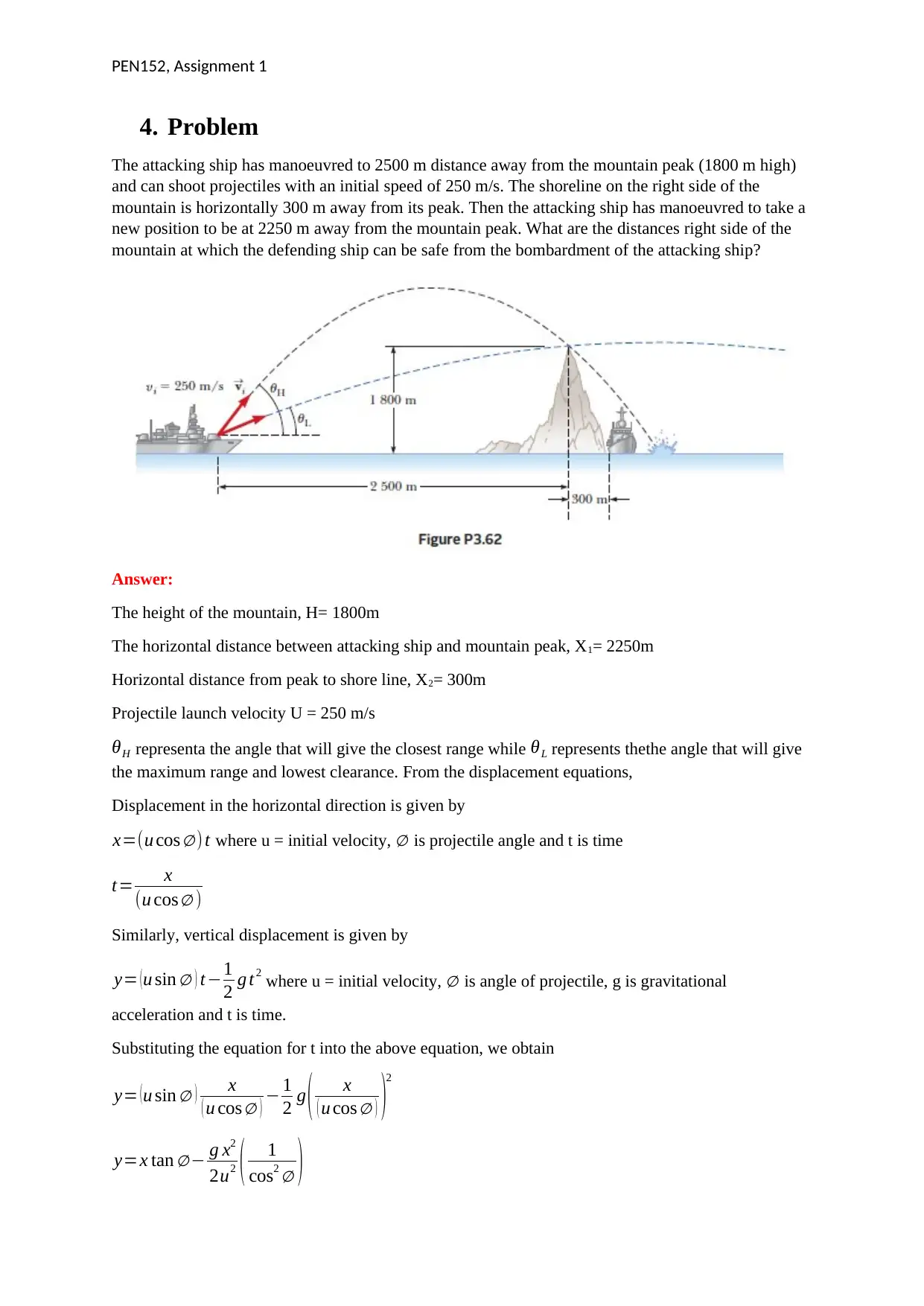
PEN152, Assignment 1
4. Problem
The attacking ship has manoeuvred to 2500 m distance away from the mountain peak (1800 m high)
and can shoot projectiles with an initial speed of 250 m/s. The shoreline on the right side of the
mountain is horizontally 300 m away from its peak. Then the attacking ship has manoeuvred to take a
new position to be at 2250 m away from the mountain peak. What are the distances right side of the
mountain at which the defending ship can be safe from the bombardment of the attacking ship?
Answer:
The height of the mountain, H= 1800m
The horizontal distance between attacking ship and mountain peak, X1= 2250m
Horizontal distance from peak to shore line, X2= 300m
Projectile launch velocity U = 250 m/s
θH representa the angle that will give the closest range while θL represents thethe angle that will give
the maximum range and lowest clearance. From the displacement equations,
Displacement in the horizontal direction is given by
x=(u cos ∅) t where u = initial velocity, ∅ is projectile angle and t is time
t= x
(u cos∅ )
Similarly, vertical displacement is given by
y= (u sin ∅ ) t−1
2 g t2 where u = initial velocity, ∅ is angle of projectile, g is gravitational
acceleration and t is time.
Substituting the equation for t into the above equation, we obtain
y= (u sin ∅ ) x
( u cos ∅ ) − 1
2 g ( x
( u cos ∅ ) )2
y=x tan ∅ − g x2
2u2 ( 1
cos2 ∅ )
4. Problem
The attacking ship has manoeuvred to 2500 m distance away from the mountain peak (1800 m high)
and can shoot projectiles with an initial speed of 250 m/s. The shoreline on the right side of the
mountain is horizontally 300 m away from its peak. Then the attacking ship has manoeuvred to take a
new position to be at 2250 m away from the mountain peak. What are the distances right side of the
mountain at which the defending ship can be safe from the bombardment of the attacking ship?
Answer:
The height of the mountain, H= 1800m
The horizontal distance between attacking ship and mountain peak, X1= 2250m
Horizontal distance from peak to shore line, X2= 300m
Projectile launch velocity U = 250 m/s
θH representa the angle that will give the closest range while θL represents thethe angle that will give
the maximum range and lowest clearance. From the displacement equations,
Displacement in the horizontal direction is given by
x=(u cos ∅) t where u = initial velocity, ∅ is projectile angle and t is time
t= x
(u cos∅ )
Similarly, vertical displacement is given by
y= (u sin ∅ ) t−1
2 g t2 where u = initial velocity, ∅ is angle of projectile, g is gravitational
acceleration and t is time.
Substituting the equation for t into the above equation, we obtain
y= (u sin ∅ ) x
( u cos ∅ ) − 1
2 g ( x
( u cos ∅ ) )2
y=x tan ∅ − g x2
2u2 ( 1
cos2 ∅ )
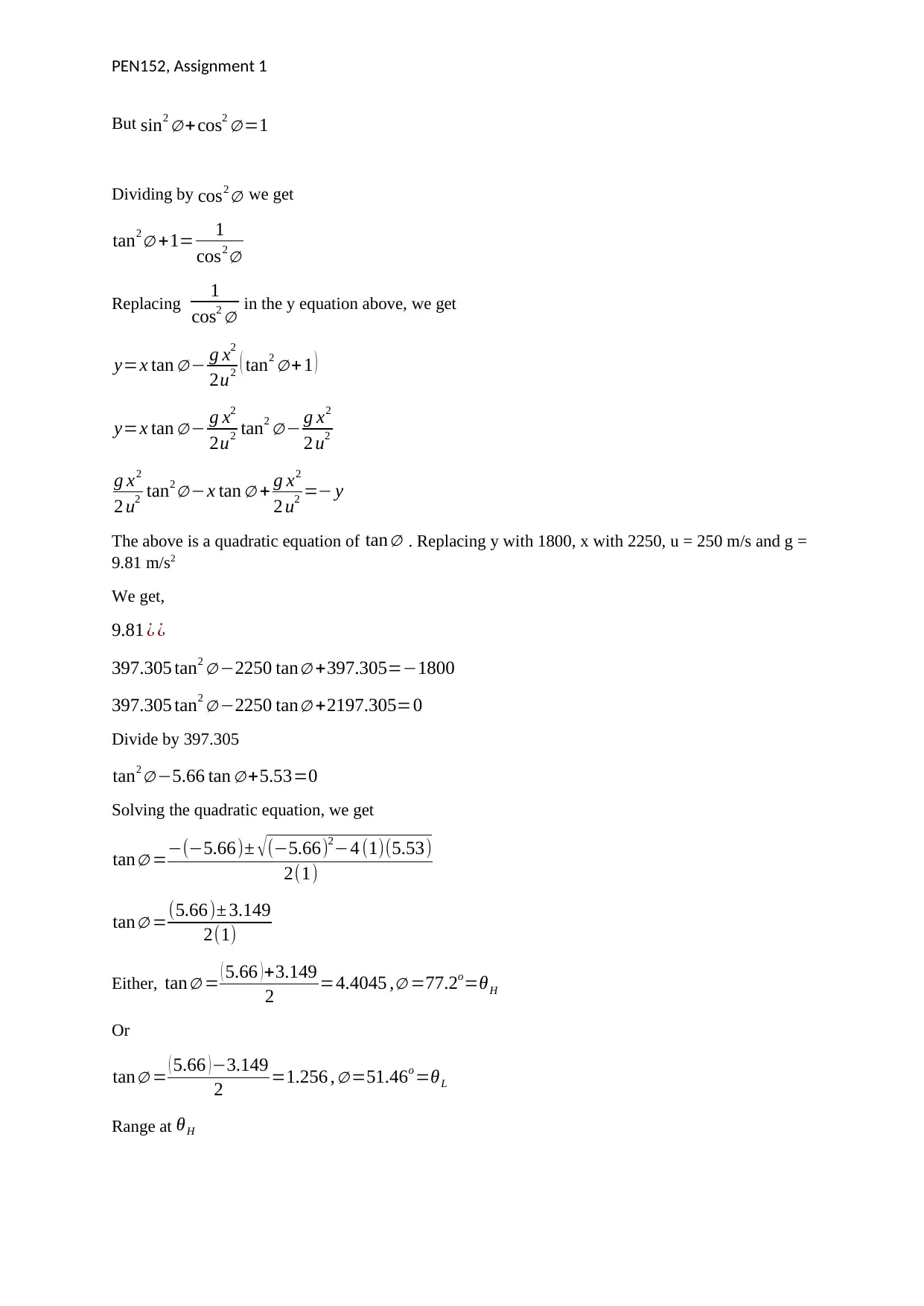
PEN152, Assignment 1
But sin2 ∅ + cos2 ∅ =1
Dividing by cos2 ∅ we get
tan2 ∅ +1= 1
cos2 ∅
Replacing 1
cos2 ∅ in the y equation above, we get
y=x tan ∅ − g x2
2u2 ( tan2 ∅ + 1 )
y=x tan ∅ − g x2
2u2 tan2 ∅ − g x2
2 u2
g x2
2 u2 tan2 ∅ −x tan ∅ + g x2
2 u2 =− y
The above is a quadratic equation of tan ∅ . Replacing y with 1800, x with 2250, u = 250 m/s and g =
9.81 m/s2
We get,
9.81 ¿ ¿
397.305 tan2 ∅ −2250 tan∅ +397.305=−1800
397.305 tan2 ∅ −2250 tan∅ +2197.305=0
Divide by 397.305
tan2 ∅ −5.66 tan ∅ +5.53=0
Solving the quadratic equation, we get
tan∅ =−(−5.66)± √(−5.66)2−4 (1)(5.53)
2(1)
tan ∅ =(5.66)± 3.149
2(1)
Either, tan∅ = ( 5.66 )+3.149
2 =4.4045 ,∅ =77.2o=θH
Or
tan∅ = ( 5.66 )−3.149
2 =1.256 , ∅ =51.46o =θL
Range at θH
But sin2 ∅ + cos2 ∅ =1
Dividing by cos2 ∅ we get
tan2 ∅ +1= 1
cos2 ∅
Replacing 1
cos2 ∅ in the y equation above, we get
y=x tan ∅ − g x2
2u2 ( tan2 ∅ + 1 )
y=x tan ∅ − g x2
2u2 tan2 ∅ − g x2
2 u2
g x2
2 u2 tan2 ∅ −x tan ∅ + g x2
2 u2 =− y
The above is a quadratic equation of tan ∅ . Replacing y with 1800, x with 2250, u = 250 m/s and g =
9.81 m/s2
We get,
9.81 ¿ ¿
397.305 tan2 ∅ −2250 tan∅ +397.305=−1800
397.305 tan2 ∅ −2250 tan∅ +2197.305=0
Divide by 397.305
tan2 ∅ −5.66 tan ∅ +5.53=0
Solving the quadratic equation, we get
tan∅ =−(−5.66)± √(−5.66)2−4 (1)(5.53)
2(1)
tan ∅ =(5.66)± 3.149
2(1)
Either, tan∅ = ( 5.66 )+3.149
2 =4.4045 ,∅ =77.2o=θH
Or
tan∅ = ( 5.66 )−3.149
2 =1.256 , ∅ =51.46o =θL
Range at θH
⊘ This is a preview!⊘
Do you want full access?
Subscribe today to unlock all pages.

Trusted by 1+ million students worldwide
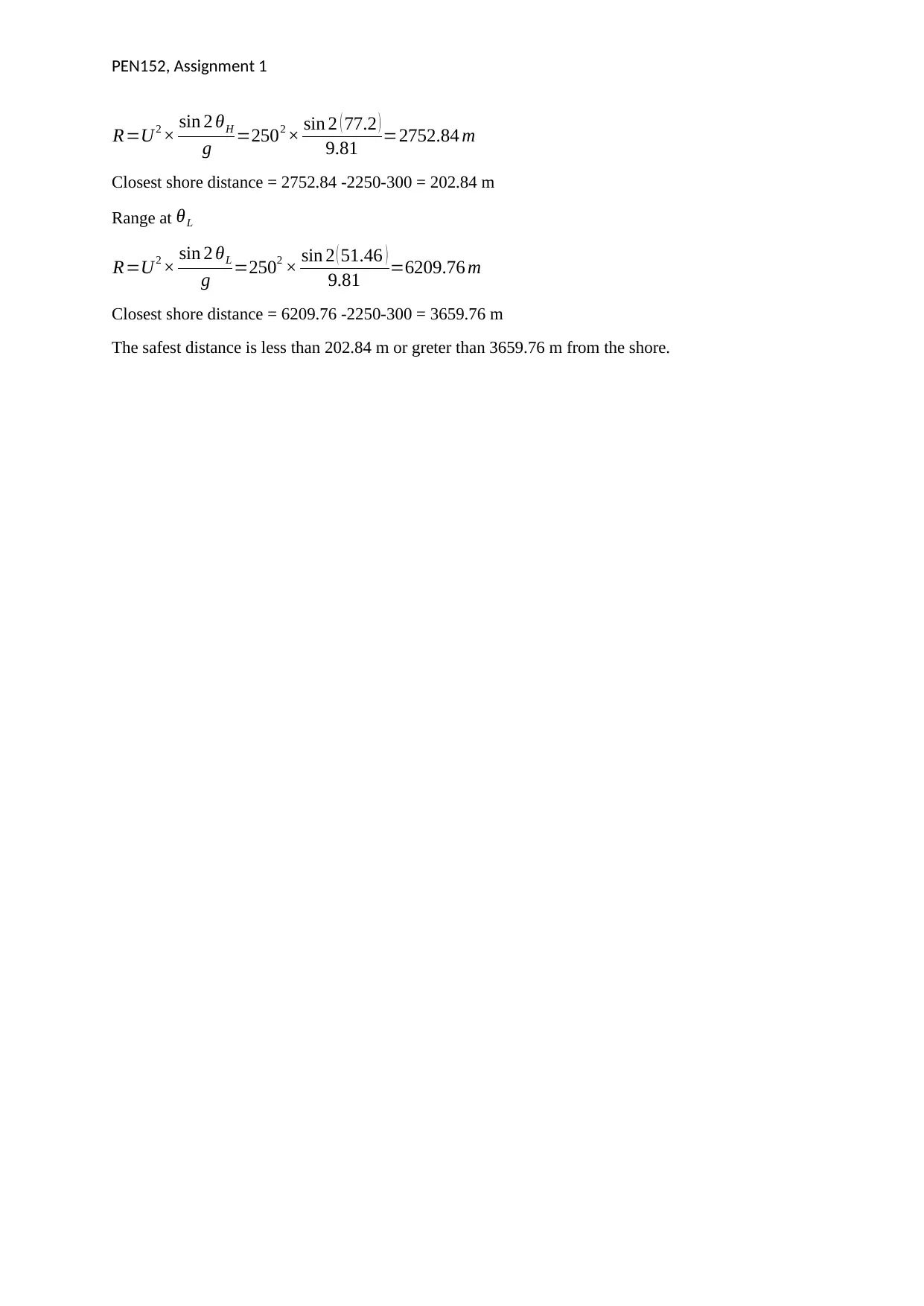
PEN152, Assignment 1
R=U2 × sin 2 θH
g =2502 × sin 2 ( 77.2 )
9.81 =2752.84 m
Closest shore distance = 2752.84 -2250-300 = 202.84 m
Range at θL
R=U2 × sin 2 θL
g =2502 × sin 2 ( 51.46 )
9.81 =6209.76 m
Closest shore distance = 6209.76 -2250-300 = 3659.76 m
The safest distance is less than 202.84 m or greter than 3659.76 m from the shore.
R=U2 × sin 2 θH
g =2502 × sin 2 ( 77.2 )
9.81 =2752.84 m
Closest shore distance = 2752.84 -2250-300 = 202.84 m
Range at θL
R=U2 × sin 2 θL
g =2502 × sin 2 ( 51.46 )
9.81 =6209.76 m
Closest shore distance = 6209.76 -2250-300 = 3659.76 m
The safest distance is less than 202.84 m or greter than 3659.76 m from the shore.
Paraphrase This Document
Need a fresh take? Get an instant paraphrase of this document with our AI Paraphraser
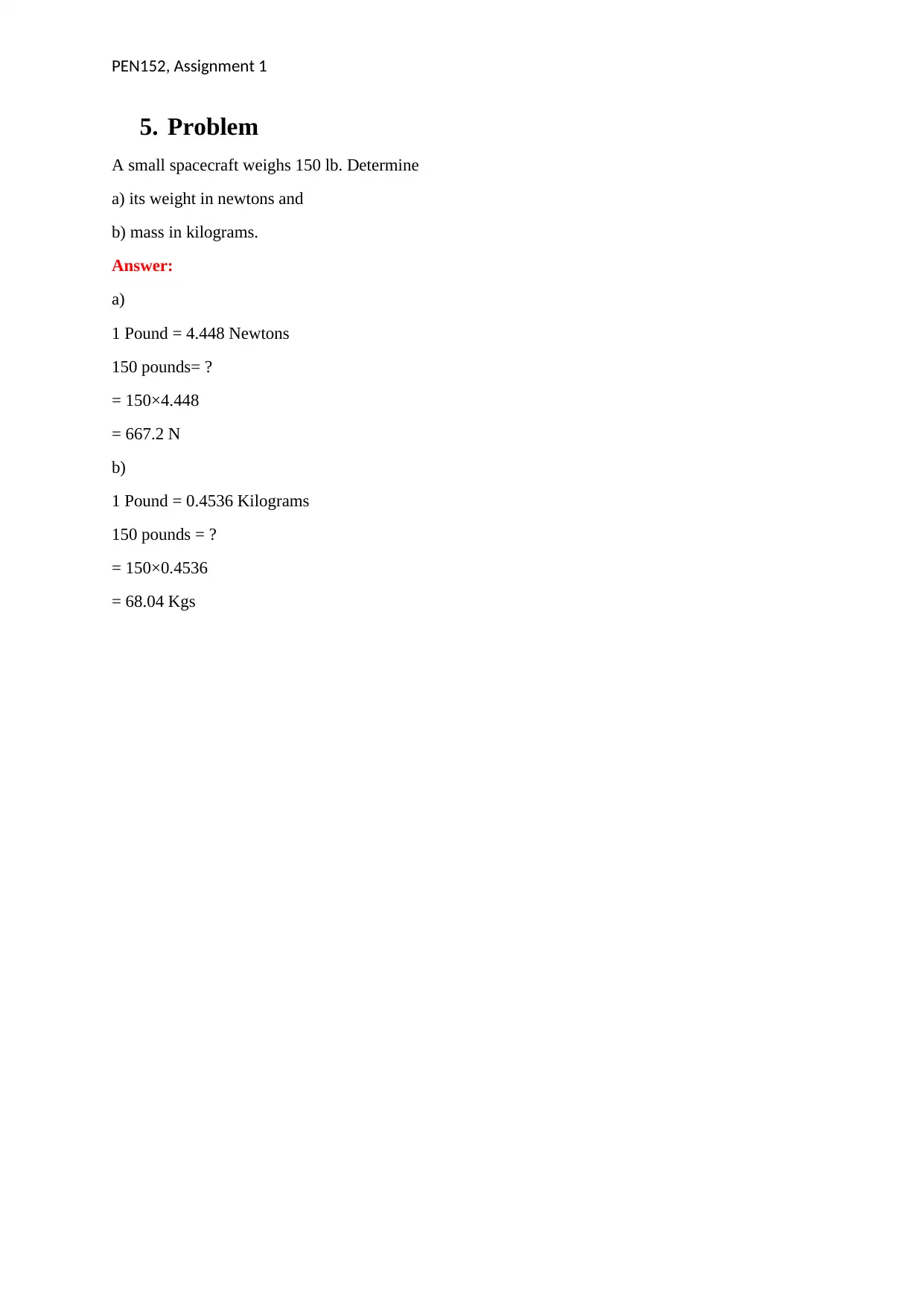
PEN152, Assignment 1
5. Problem
A small spacecraft weighs 150 lb. Determine
a) its weight in newtons and
b) mass in kilograms.
Answer:
a)
1 Pound = 4.448 Newtons
150 pounds= ?
= 150×4.448
= 667.2 N
b)
1 Pound = 0.4536 Kilograms
150 pounds = ?
= 150×0.4536
= 68.04 Kgs
5. Problem
A small spacecraft weighs 150 lb. Determine
a) its weight in newtons and
b) mass in kilograms.
Answer:
a)
1 Pound = 4.448 Newtons
150 pounds= ?
= 150×4.448
= 667.2 N
b)
1 Pound = 0.4536 Kilograms
150 pounds = ?
= 150×0.4536
= 68.04 Kgs
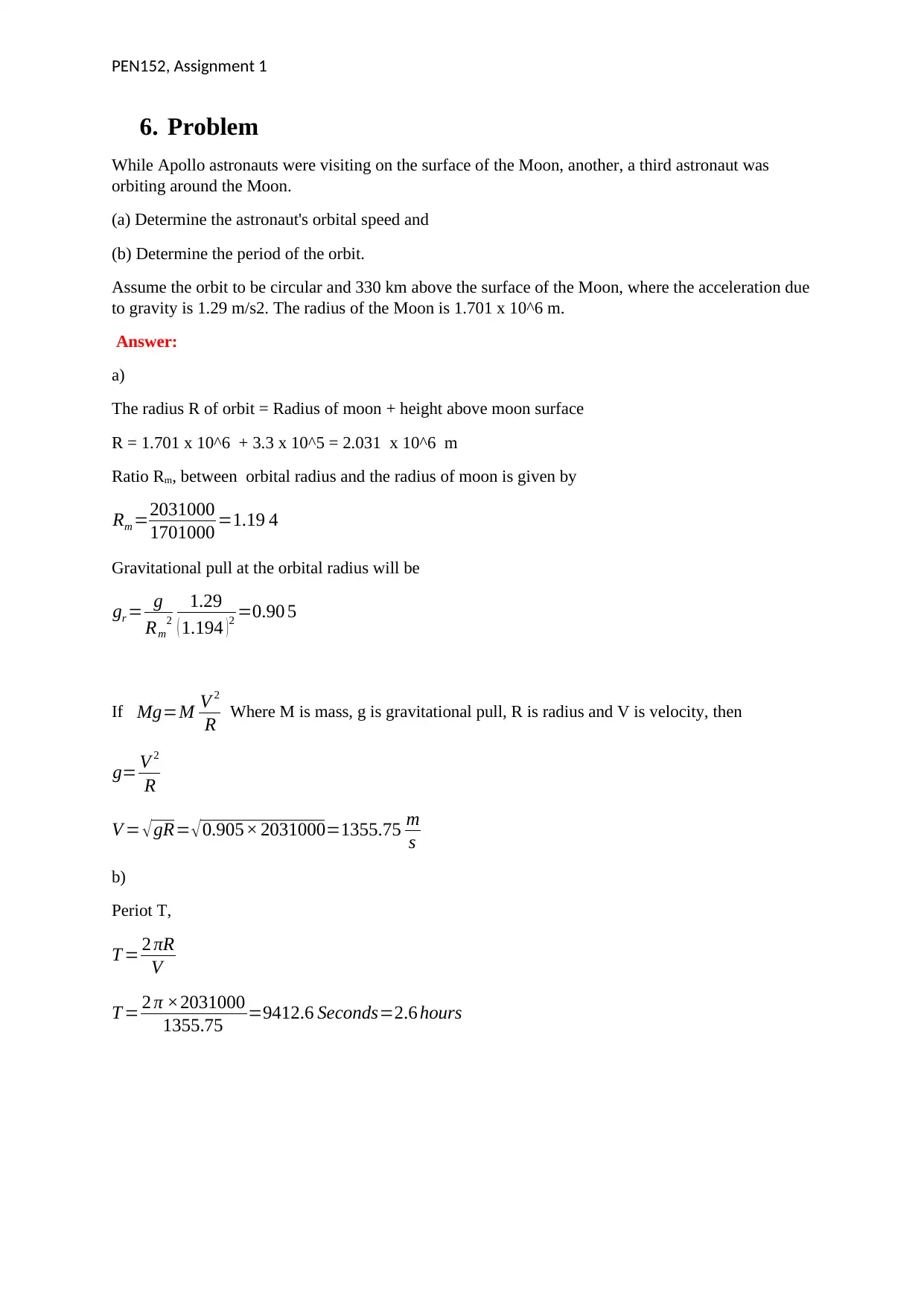
PEN152, Assignment 1
6. Problem
While Apollo astronauts were visiting on the surface of the Moon, another, a third astronaut was
orbiting around the Moon.
(a) Determine the astronaut's orbital speed and
(b) Determine the period of the orbit.
Assume the orbit to be circular and 330 km above the surface of the Moon, where the acceleration due
to gravity is 1.29 m/s2. The radius of the Moon is 1.701 x 10^6 m.
Answer:
a)
The radius R of orbit = Radius of moon + height above moon surface
R = 1.701 x 10^6 + 3.3 x 10^5 = 2.031 x 10^6 m
Ratio Rm, between orbital radius and the radius of moon is given by
Rm =2031000
1701000 =1.19 4
Gravitational pull at the orbital radius will be
gr = g
Rm
2
1.29
( 1.194 )2 =0.90 5
If Mg=M V 2
R Where M is mass, g is gravitational pull, R is radius and V is velocity, then
g= V 2
R
V = √ gR= √ 0.905× 2031000=1355.75 m
s
b)
Periot T,
T = 2 πR
V
T = 2 π ×2031000
1355.75 =9412.6 Seconds=2.6 hours
6. Problem
While Apollo astronauts were visiting on the surface of the Moon, another, a third astronaut was
orbiting around the Moon.
(a) Determine the astronaut's orbital speed and
(b) Determine the period of the orbit.
Assume the orbit to be circular and 330 km above the surface of the Moon, where the acceleration due
to gravity is 1.29 m/s2. The radius of the Moon is 1.701 x 10^6 m.
Answer:
a)
The radius R of orbit = Radius of moon + height above moon surface
R = 1.701 x 10^6 + 3.3 x 10^5 = 2.031 x 10^6 m
Ratio Rm, between orbital radius and the radius of moon is given by
Rm =2031000
1701000 =1.19 4
Gravitational pull at the orbital radius will be
gr = g
Rm
2
1.29
( 1.194 )2 =0.90 5
If Mg=M V 2
R Where M is mass, g is gravitational pull, R is radius and V is velocity, then
g= V 2
R
V = √ gR= √ 0.905× 2031000=1355.75 m
s
b)
Periot T,
T = 2 πR
V
T = 2 π ×2031000
1355.75 =9412.6 Seconds=2.6 hours
⊘ This is a preview!⊘
Do you want full access?
Subscribe today to unlock all pages.

Trusted by 1+ million students worldwide
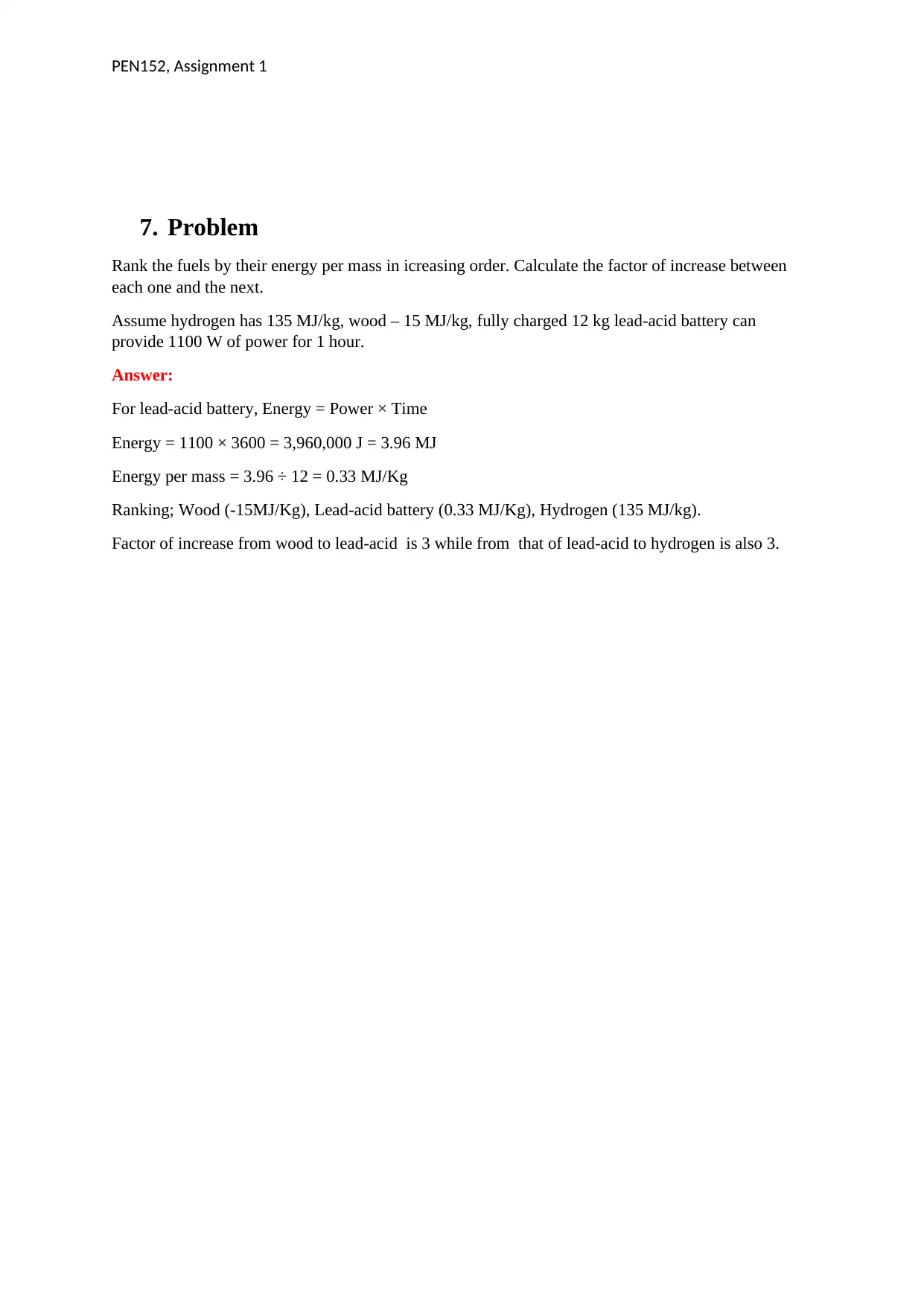
PEN152, Assignment 1
7. Problem
Rank the fuels by their energy per mass in icreasing order. Calculate the factor of increase between
each one and the next.
Assume hydrogen has 135 MJ/kg, wood – 15 MJ/kg, fully charged 12 kg lead-acid battery can
provide 1100 W of power for 1 hour.
Answer:
For lead-acid battery, Energy = Power × Time
Energy = 1100 × 3600 = 3,960,000 J = 3.96 MJ
Energy per mass = 3.96 ÷ 12 = 0.33 MJ/Kg
Ranking; Wood (-15MJ/Kg), Lead-acid battery (0.33 MJ/Kg), Hydrogen (135 MJ/kg).
Factor of increase from wood to lead-acid is 3 while from that of lead-acid to hydrogen is also 3.
7. Problem
Rank the fuels by their energy per mass in icreasing order. Calculate the factor of increase between
each one and the next.
Assume hydrogen has 135 MJ/kg, wood – 15 MJ/kg, fully charged 12 kg lead-acid battery can
provide 1100 W of power for 1 hour.
Answer:
For lead-acid battery, Energy = Power × Time
Energy = 1100 × 3600 = 3,960,000 J = 3.96 MJ
Energy per mass = 3.96 ÷ 12 = 0.33 MJ/Kg
Ranking; Wood (-15MJ/Kg), Lead-acid battery (0.33 MJ/Kg), Hydrogen (135 MJ/kg).
Factor of increase from wood to lead-acid is 3 while from that of lead-acid to hydrogen is also 3.
Paraphrase This Document
Need a fresh take? Get an instant paraphrase of this document with our AI Paraphraser
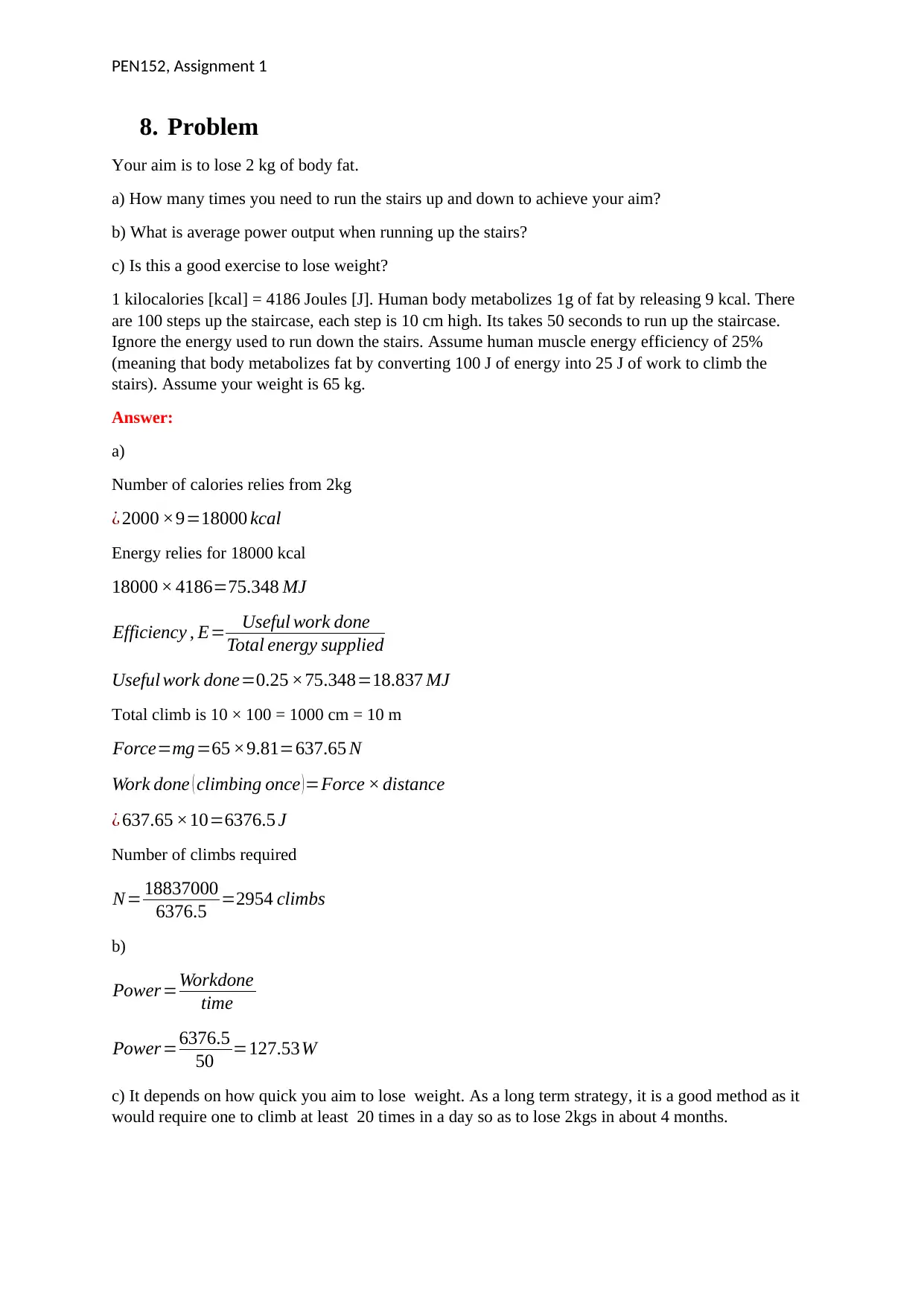
PEN152, Assignment 1
8. Problem
Your aim is to lose 2 kg of body fat.
a) How many times you need to run the stairs up and down to achieve your aim?
b) What is average power output when running up the stairs?
c) Is this a good exercise to lose weight?
1 kilocalories [kcal] = 4186 Joules [J]. Human body metabolizes 1g of fat by releasing 9 kcal. There
are 100 steps up the staircase, each step is 10 cm high. Its takes 50 seconds to run up the staircase.
Ignore the energy used to run down the stairs. Assume human muscle energy efficiency of 25%
(meaning that body metabolizes fat by converting 100 J of energy into 25 J of work to climb the
stairs). Assume your weight is 65 kg.
Answer:
a)
Number of calories relies from 2kg
¿ 2000 ×9=18000 kcal
Energy relies for 18000 kcal
18000 × 4186=75.348 MJ
Efficiency , E= Useful work done
Total energy supplied
Useful work done=0.25 ×75.348=18.837 MJ
Total climb is 10 × 100 = 1000 cm = 10 m
Force=mg=65 ×9.81=637.65 N
Work done ( climbing once ) =Force × distance
¿ 637.65 ×10=6376.5 J
Number of climbs required
N= 18837000
6376.5 =2954 climbs
b)
Power=Workdone
time
Power=6376.5
50 =127.53W
c) It depends on how quick you aim to lose weight. As a long term strategy, it is a good method as it
would require one to climb at least 20 times in a day so as to lose 2kgs in about 4 months.
8. Problem
Your aim is to lose 2 kg of body fat.
a) How many times you need to run the stairs up and down to achieve your aim?
b) What is average power output when running up the stairs?
c) Is this a good exercise to lose weight?
1 kilocalories [kcal] = 4186 Joules [J]. Human body metabolizes 1g of fat by releasing 9 kcal. There
are 100 steps up the staircase, each step is 10 cm high. Its takes 50 seconds to run up the staircase.
Ignore the energy used to run down the stairs. Assume human muscle energy efficiency of 25%
(meaning that body metabolizes fat by converting 100 J of energy into 25 J of work to climb the
stairs). Assume your weight is 65 kg.
Answer:
a)
Number of calories relies from 2kg
¿ 2000 ×9=18000 kcal
Energy relies for 18000 kcal
18000 × 4186=75.348 MJ
Efficiency , E= Useful work done
Total energy supplied
Useful work done=0.25 ×75.348=18.837 MJ
Total climb is 10 × 100 = 1000 cm = 10 m
Force=mg=65 ×9.81=637.65 N
Work done ( climbing once ) =Force × distance
¿ 637.65 ×10=6376.5 J
Number of climbs required
N= 18837000
6376.5 =2954 climbs
b)
Power=Workdone
time
Power=6376.5
50 =127.53W
c) It depends on how quick you aim to lose weight. As a long term strategy, it is a good method as it
would require one to climb at least 20 times in a day so as to lose 2kgs in about 4 months.
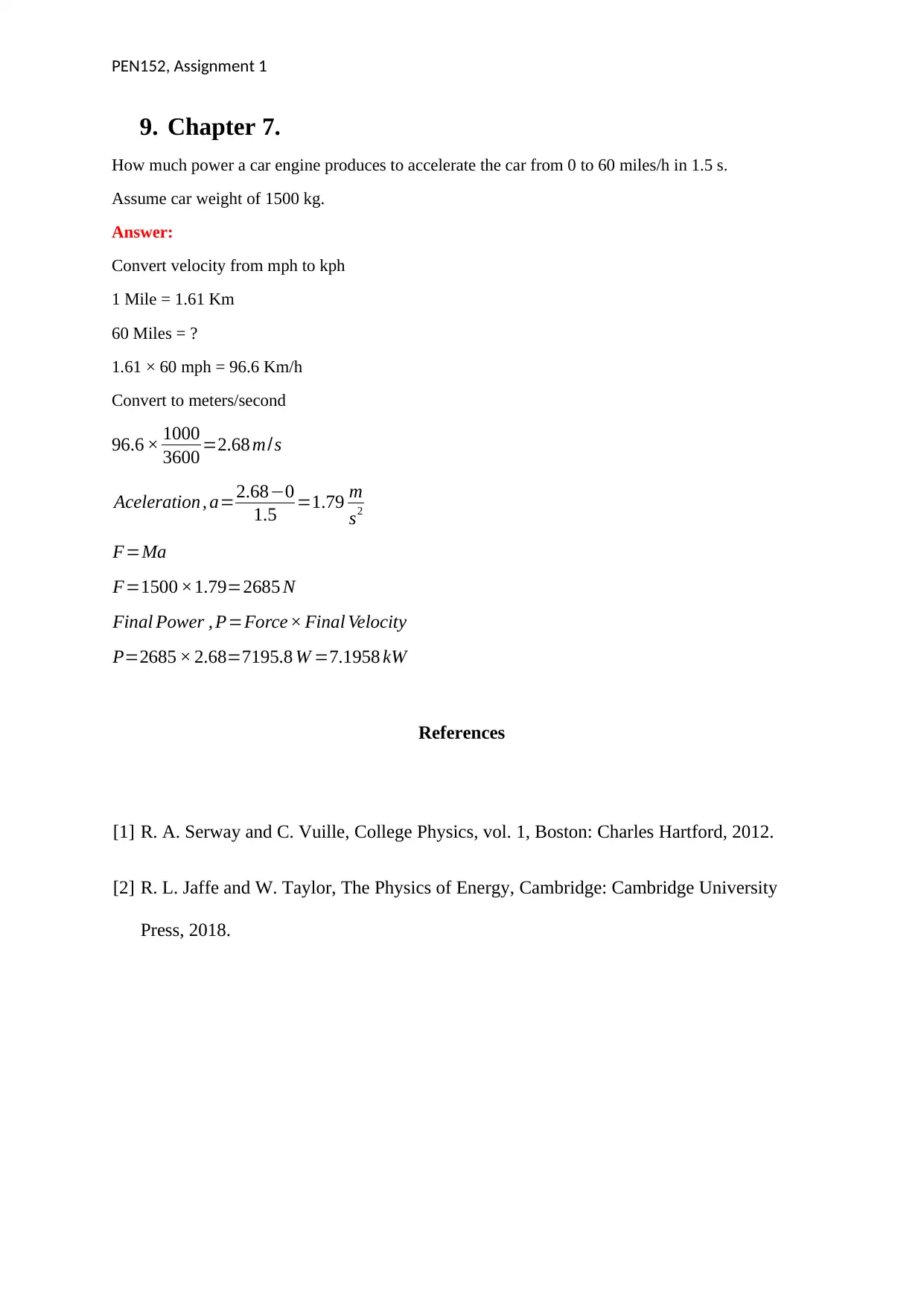
PEN152, Assignment 1
9. Chapter 7.
How much power a car engine produces to accelerate the car from 0 to 60 miles/h in 1.5 s.
Assume car weight of 1500 kg.
Answer:
Convert velocity from mph to kph
1 Mile = 1.61 Km
60 Miles = ?
1.61 × 60 mph = 96.6 Km/h
Convert to meters/second
96.6 × 1000
3600 =2.68 m/s
Aceleration, a=2.68−0
1.5 =1.79 m
s2
F=Ma
F=1500 ×1.79=2685 N
Final Power , P=Force× Final Velocity
P=2685 × 2.68=7195.8 W =7.1958 kW
References
[1] R. A. Serway and C. Vuille, College Physics, vol. 1, Boston: Charles Hartford, 2012.
[2] R. L. Jaffe and W. Taylor, The Physics of Energy, Cambridge: Cambridge University
Press, 2018.
9. Chapter 7.
How much power a car engine produces to accelerate the car from 0 to 60 miles/h in 1.5 s.
Assume car weight of 1500 kg.
Answer:
Convert velocity from mph to kph
1 Mile = 1.61 Km
60 Miles = ?
1.61 × 60 mph = 96.6 Km/h
Convert to meters/second
96.6 × 1000
3600 =2.68 m/s
Aceleration, a=2.68−0
1.5 =1.79 m
s2
F=Ma
F=1500 ×1.79=2685 N
Final Power , P=Force× Final Velocity
P=2685 × 2.68=7195.8 W =7.1958 kW
References
[1] R. A. Serway and C. Vuille, College Physics, vol. 1, Boston: Charles Hartford, 2012.
[2] R. L. Jaffe and W. Taylor, The Physics of Energy, Cambridge: Cambridge University
Press, 2018.
⊘ This is a preview!⊘
Do you want full access?
Subscribe today to unlock all pages.

Trusted by 1+ million students worldwide
1 out of 12
Related Documents
Your All-in-One AI-Powered Toolkit for Academic Success.
+13062052269
info@desklib.com
Available 24*7 on WhatsApp / Email
![[object Object]](/_next/static/media/star-bottom.7253800d.svg)
Unlock your academic potential
Copyright © 2020–2025 A2Z Services. All Rights Reserved. Developed and managed by ZUCOL.





